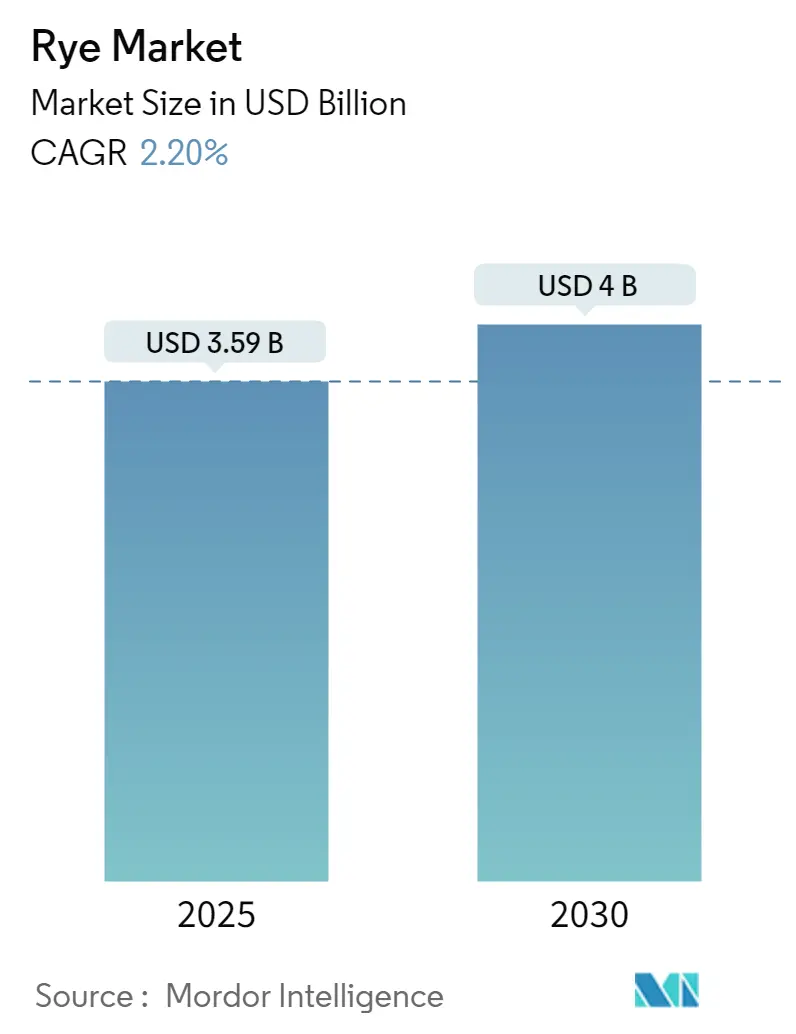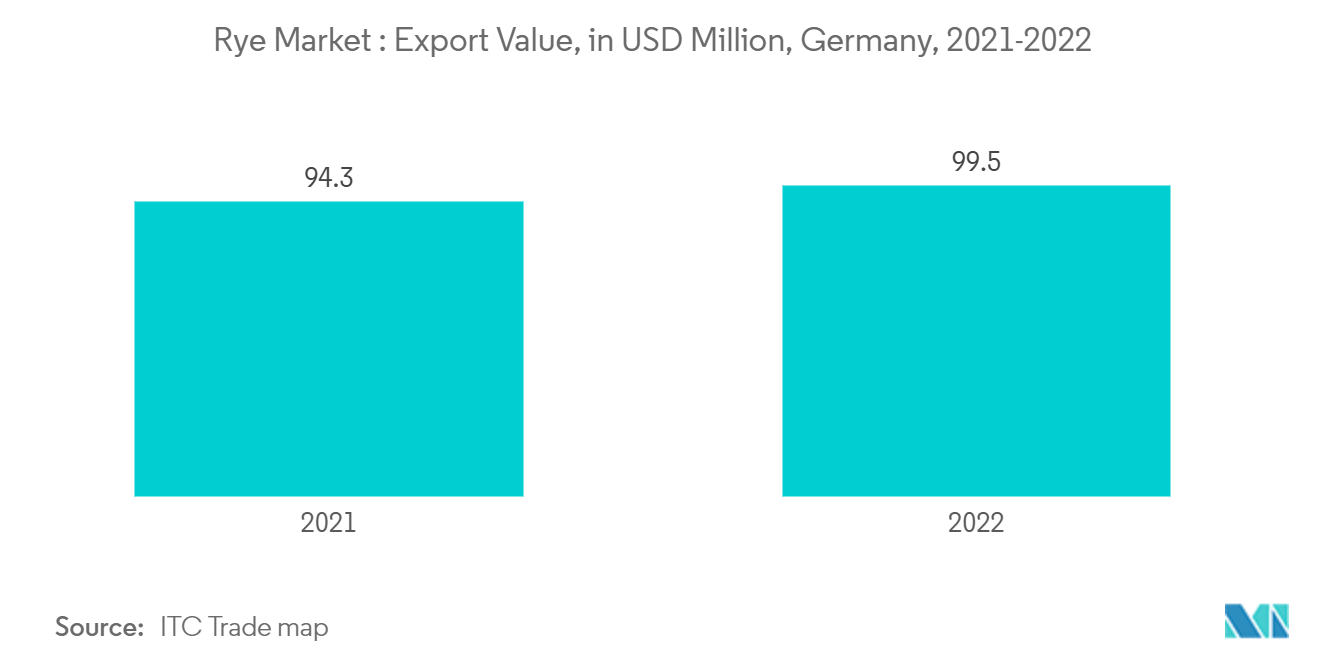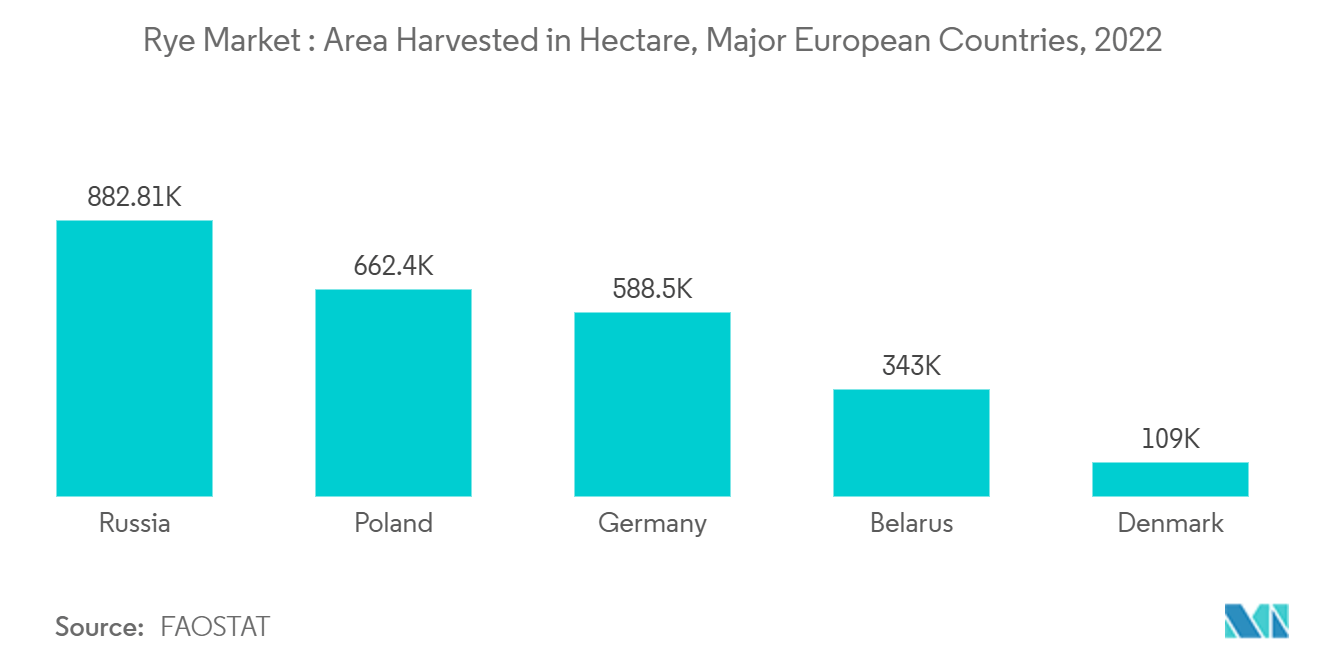Rye Market Analysis
The Rye Market size is estimated at USD 3.59 billion in 2025, and is expected to reach USD 4.00 billion by 2030, at a CAGR of 2.2% during the forecast period (2025-2030).
Rye is a nutrient-dense grain, rich in vitamin B6, thiamine, niacin, iron, folate, fiber, and riboflavin. It also contains smaller quantities of zinc, pantothenic acid, phosphorus, magnesium, calcium, and other micronutrients. Consumption of rye may contribute to improved heart health, better blood sugar control, enhanced digestive health, reduced inflammation, and a lower risk of certain cancers.
According to the Food and Agriculture Organization (FAO), Germany, Poland, Russia, Belarus, Denmark, Ukraine, and China are the major producers of rye across the globe contributing 3,132.3 thousand metric tons, followed by 2,337.1 thousand metric tons, 2,178.8 thousand metric tons, 750 thousand metric tons, 691.4 thousand metric tons, 314.0 thousand metric tons, and 500.8 thousand metric tons during the year 2022.
Rye holds significant importance in many European countries, particularly in Northern Europe. It is well-suited for regions with poor soil quality and can withstand colder temperatures compared to other grains. The growing demand from the food and beverage processing industry is driving market growth for rye.
Rye whiskey gains its distinctive spicy and flavorful profile from the grain's complexity. New hybrid varieties, such as Abruzzese Rye, Danko Rye, and Brasetto Rye, are being evaluated by universities like Penn State for their suitability to specific climate and soil conditions. These varieties are utilized by distillers, brewers, and bakers, and are also commonly employed as cover crops. Therefore, the increased demand for rye in the bakery & beverage industry and the rise in production are anticipated to drive the market across the region during the forecast period.
Rye Market Trends
Increasing Export Oriented Agriculture Boosting Rye Production
The global production of rye is increasing in response to growing worldwide demand. European countries have been focusing on exports as a significant revenue source, contributing to the overall growth of the global cereal export market and, consequently, the rye market. Several European nations have initiated or expanded their rye exports to major international markets, broadening the global export potential.
According to UN COMTRADE data, in 2022, Europe accounted for over 89% of global rye exports. Major European exporters, including Germany, Poland, Russia, Latvia, Ukraine, and Lithuania, primarily target markets in North America, Western Europe, and Japan. The two main consumers of rye, Europe and North America, source the grain from European countries, further stimulating the market in the region as consumption in these areas increases.
The United Nations Commodity Trade Database reports that in 2022, Germany, Poland, and Russia were the top three rye-exporting countries globally. Together, these three nations accounted for approximately 67.8% of global rye exports in 2022. Moreover, exports from these countries have shown an upward trend over recent years. For example, according to the ITC trade map, Germany's export value increased by more than 34.1% from 2019 to 2023. The expanding export opportunities and diversification of export destinations are anticipated to drive market growth in the coming years.
Europe Dominates the Market
Rye cultivation is predominantly concentrated in Eastern, Central, and Northern Europe. The main rye production belt extends from northern Germany through Poland, Ukraine, Belarus, Lithuania, and Latvia into central and northern Russia. Germany and Poland stand out as the principal producers and consumers of rye in Europe. According to FAOSTAT, Germany and Poland consistently demonstrate high rye yields, with Germany producing up to 3,132.3 thousand metric tons and Poland up to 2,337.1 thousand metric tons in 2022. The Food and Agriculture Organization (FAO) reports that in 2022, Russia led in harvested area with 882.8 thousand hectares, followed by Poland with 662.4 thousand hectares, and Germany with 588.5 thousand hectares. These figures indicate potential for further market growth in the coming years.
Approximately half of the rye produced is utilized in animal feed. The growing demand for rye in alcohol production has further increased its consumption within the region during the forecast period. The crop's high yield has enabled EU countries to engage in rye trade with other nations. According to Eurostat, domestic prices in the EU have decreased, facilitating exports. It's noteworthy that domestic rye prices in the EU are significantly influenced by corn prices.
Rye Market News
- January 2023: Powers Irish Whiskey launched the world's first 100% Irish rye whiskey bottled at 43.2% ABV. Powers Irish Rye is released in the United States, Ireland, Northern Ireland, Dublin Airport, and online platforms.
- July 2022: Danone launched Alpro Totally Nordic Rye across Sweden and Finland. The drink is a plant-based alternative to milk and the first of its kind based on rye grain.
- August 2021: In the United States, northeastern Iowa farmers used hybrid rye to help reduce ragweeds without using herbicides on row crops such as corn and soy.
Rye Industry Segmentation
Rye is one of the important field crops grown for food and forage use. The crop belongs to the triticale family. The grain is extensively used in bakery products, alcoholic beverages, and animal feed. The rye market is segmented by geography into North America, Europe, Asia-Pacific, South America, and the Middle East. The report offers an analysis of production (volume), consumption (value and volume), import (value and volume), export (value and volume), and price trend analysis. The report offers market size and forecasts regarding value (USD) and volume (metric tons) for all the above segments.
| Geography | North America | United States | Production Analysis | |
| Consumption Analysis and Market Value | ||||
| Import Market Analysis (Volume & Value) | ||||
| Export Market Analysis (Volume & Value) | ||||
| Price Trends Analysis | ||||
| Canada | Production Analysis | |||
| Consumption Analysis and Market Value | ||||
| Import Market Analysis (Volume & Value) | ||||
| Export Market Analysis (Volume & Value) | ||||
| Price Trends Analysis | ||||
| Europe | Germany | Production Analysis | ||
| Consumption Analysis and Market Value | ||||
| Import Market Analysis (Volume & Value) | ||||
| Export Market Analysis (Volume & Value) | ||||
| Price Trends Analysis | ||||
| Ukraine | Production Analysis | |||
| Consumption Analysis and Market Value | ||||
| Import Market Analysis (Volume & Value) | ||||
| Export Market Analysis (Volume & Value) | ||||
| Price Trends Analysis | ||||
| Russia | Production Analysis | |||
| Consumption Analysis and Market Value | ||||
| Import Market Analysis (Volume & Value) | ||||
| Export Market Analysis (Volume & Value) | ||||
| Price Trends Analysis | ||||
| Poland | Production Analysis | |||
| Consumption Analysis and Market Value | ||||
| Import Market Analysis (Volume & Value) | ||||
| Export Market Analysis (Volume & Value) | ||||
| Price Trends Analysis | ||||
| Asia-Pacific | China | Production Analysis | ||
| Consumption Analysis and Market Value | ||||
| Import Market Analysis (Volume & Value) | ||||
| Export Market Analysis (Volume & Value) | ||||
| Price Trends Analysis | ||||
| Australia | Production Analysis | |||
| Consumption Analysis and Market Value | ||||
| Import Market Analysis (Volume & Value) | ||||
| Export Market Analysis (Volume & Value) | ||||
| Price Trends Analysis | ||||
| South America | Brazil | Production Analysis | ||
| Consumption Analysis and Market Value | ||||
| Import Market Analysis (Volume & Value) | ||||
| Export Market Analysis (Volume & Value) | ||||
| Price Trends Analysis | ||||
| Argentina | Production Analysis | |||
| Consumption Analysis and Market Value | ||||
| Import Market Analysis (Volume & Value) | ||||
| Export Market Analysis (Volume & Value) | ||||
| Price Trends Analysis | ||||
| Middle East | Turkey | Production Analysis | ||
| Consumption Analysis and Market Value | ||||
| Import Market Analysis (Volume & Value) | ||||
| Export Market Analysis (Volume & Value) | ||||
| Price Trends Analysis | ||||
| Israel | Production Analysis | |||
| Consumption Analysis and Market Value | ||||
| Import Market Analysis (Volume & Value) | ||||
| Export Market Analysis (Volume & Value) | ||||
| Price Trends Analysis | ||||
Rye Market Research FAQs
How big is the Rye Market?
The Rye Market size is expected to reach USD 3.59 billion in 2025 and grow at a CAGR of 2.20% to reach USD 4.00 billion by 2030.
What is the current Rye Market size?
In 2025, the Rye Market size is expected to reach USD 3.59 billion.
Which is the fastest growing region in Rye Market?
North America is estimated to grow at the highest CAGR over the forecast period (2025-2030).
Which region has the biggest share in Rye Market?
In 2025, the Europe accounts for the largest market share in Rye Market.
What years does this Rye Market cover, and what was the market size in 2024?
In 2024, the Rye Market size was estimated at USD 3.51 billion. The report covers the Rye Market historical market size for years: 2019, 2020, 2021, 2022, 2023 and 2024. The report also forecasts the Rye Market size for years: 2025, 2026, 2027, 2028, 2029 and 2030.
Our Best Selling Reports
Rye Industry Report
Statistics for the 2025 Rye market share, size and revenue growth rate, created by Mordor Intelligence™ Industry Reports. Rye analysis includes a market forecast outlook for 2025 to 2030 and historical overview. Get a sample of this industry analysis as a free report PDF download.





